Physical Address
304 North Cardinal St.
Dorchester Center, MA 02124

(Continued from page 2)
Academic author Michael Ward includes a brief passage about this film in a fascinating thesis paper, The Noose Among the Cherries, about the depiction of Korean characters in Japanese Cinema.1 According to Ward, The Eleventh Hour was one of the first two Japanese films (after Kobayashi Masaki’s The Thick-Walled Room (Kabe Atsuki Heya, 1953, released 1956)) to bring up the issue of discrimination against the Zainichi (resident Koreans) in Japan. Ward uses the film as an example of what he calls the “moralistic spiritual supremacy” displayed by Zainichi in Japanese films during this time period.
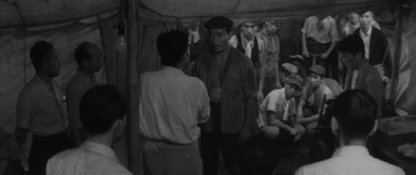
In this narrative, the Korean miners are perfectly willing to help the trapped men – until they learn about a remark by one of the managers that the only reason the workers offered to help was to get paid and then get drunk. All the Koreans are offended by this slur and, partly because of the perceived bigotry of the Japanese, they decide collectively to withdraw from the effort, even though it’s clear that the help of every single person is needed. In the end, persuaded by the arguments of their leader, Shimano (Okada Eiji), the Koreans change their minds and help free the men in the mine, on the grounds that, if a cave-in were to happen to them, they would want other miners to do the same for them.2
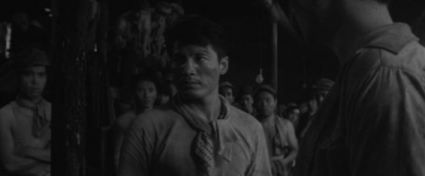
This moral decision, Ward argues, was intended by the filmmakers to show the “supremacy” of the Koreans over the Japanese who despise them, and is thus, from Ward’s point-of-view, an instance of racial idealization and stereotyping. And indeed, such a dramatic situation seems to me analogous to those of 1960s Hollywood movies with black characters (often played by Sidney Poitier) who “rise above” bigotry and prejudice by demonstrating their moral superiority to the white characters who oppress them.
But the apparent similarity of these cinematic characters from different countries becomes less obvious when we examine closely what the Korean characters actually do in Uchida’s film. The workers are angry that the managers foolishly show contempt for them while at the same time demanding their help in a crisis, and it’s clear that their anger is justified. And in context, this insult is understood by the audience not as an isolated incident, but as representing a general pattern of denigration of the Koreans by the Japanese in general (although Sunaga himself always treats them with respect). Partly in reaction to these slights, they initially vote, virtually unanimously, to stop helping the Japanese workers save their fellow miners, though they know that this choice might mean death for the unlucky men.
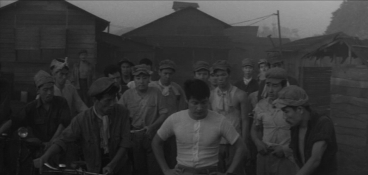
Returning to our Hollywood comparison, it’s simply impossible to imagine a character in an American movie played by Sidney Poitier refusing, even momentarily, to save the lives of some white men because other white men had insulted him. In the end, the Koreans change their minds and wind up contributing to the effort, though they’re clearly reluctant heroes. Their initial choice to boycott the rescue mission is a perfectly human reaction in context, but not at all admirable or just, particularly since the dying men in the mine have done nothing to them. So Uchida, in my opinion, treats the Korean characters as morally gray human beings, not as one-dimensional paragons of virtue.
Uchida in his lifetime was strongly associated with both Fascism and Communism. In the 1930’s, Uchida had earned a reputation as one of the most talented left-leaning moviemakers. But in 1945, he went to work, without any apparent moral qualms, for the Fascist fanatic and murderer Amakasu Masahiko. When, following the Japanese surrender, Amakasu committed suicide by taking potassium cyanide, Uchida even tried in vain to save his life. Almost immediately afterwards, however, Uchida allied himself with the Chinese Communists and later taught editing techniques to both Chinese and North Korean Communist filmmakers. He even studied Maoist ideology (though he was forced to attend these study sessions) and later incorporated what he learned in his films.
Yet despite the fact that he had alternately supported both the Far Right and the Far Left, changing sides with dizzying speed, the evidence in The Eleventh Hour suggests that, by the mid-1950s, he was rejecting political extremes. He goes out of his way to show that all sides in the class/race conflict – the Japanese bosses, the native workers, the Koreans and even the family members of the victims – are, to varying degrees, wrong, because each group perceives the opposing side according to its own prejudices, rather than reality. Uchida’s position here is both anti-Fascist – by insisting that the workers be heard and respected and not be forced to obey blindly – and anti-Marxist – by urging for some sort of tentative alliance between management and workers, rather than for the latter to overthrow the former.
In his autobiography, Uchida quoted admiringly the producer Makino Mitsuo, who once said (as translated on the Internet), “Right or Left doesn’t matter; I belong to the Dainippon [Greater Japan] Movie Party.” Uchida’s allegiance to filmmaking meant, for him, that he wouldn’t overtly support any outside ideology, but would simply tell the truth as he saw it and try to render that truth artistically in his films.
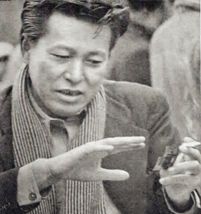
In the annual Kinema Junpo (KJ) critics’ poll, this movie was voted as the seventh-best film of 1957, a possible reflection of Uchida’s strong stance in the film against prejudice towards the Zainichi. But also in 1957, the Communist director Imai Tadashi released two socially-conscious films of his own that scored first and second place in that year’s KJ poll – The Rice People (Kome) and A Story of Pure Love (Jun’ai monogatari), respectively, and Imai had also topped the poll the previous year with a muckraking courtroom drama he directed about innocent working-class men framed for murder, Darkness at Noon (Mahiru no ankoku, 1956). So it seems very likely that had The Eleventh Hour been more obviously pro-Left in its sympathies, it might have done even better with the critics of the time.3
The Eleventh Hour contains an unambiguously happy ending. For that amazing fact, alone, it can be considered almost unique among Uchida’s films. The upbeat conclusion feels earned because it’s ultimately presented as the triumph of human empathy, not of superior planning or technology.
But the way the ending is filmed isn’t completely satisfying. Just before the resolution of the narrative, there’s a bizarre shot in which the worried family members of the victims, standing at the mine entrance, suddenly begin weeping – even though they have no reason to assume the men are dead. It’s as Uchida wants to milk every last drop of the audience’s sympathy before revealing that the men, though unconscious, have been found alive. It’s an oddly jarring and manipulative moment.
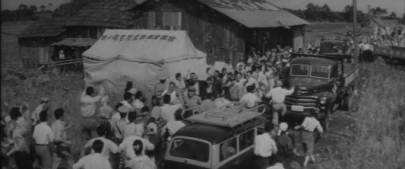
When they hear the good news of the five men’s survival over the loudspeaker, the enormous crowd explodes in a outburst of joy, which is perfectly appropriate dramatically. But the scene is definitely over-the-top, though it’s difficult to say exactly why it feels that way. It could be the shot showing Sunaga effusively thanking everyone around him for their help – even the Buddhist monk. It could be the press helicopter that drops bouquets and confetti over everyone and everything. It could be Kusaka, the Chief Miner, showing up at the mine at precisely that point, relieved at last of the terrible burden of his guilt. It could be the long shot of the smiling, cheering crowd, which looks like a Fourth of July parade. But in the end, it must be conceded that the depiction of unbridled joy was never Uchida’s forte – perhaps understandably, considering his personal experience.
A dramatically solid if not particularly inspired suspense thriller about trapped coal miners, distinguished by its admirable attention to realistic detail and strong social conscience.
YouTube: Very brief trailer, presumably for a TV broadcast
The Noose Among the Cherries: Landscape and the Representation of Resident Koreans in Japanese Film: 2015 Masters thesis by Michael Ward which mentions Dotanba in the context of the depiction, in Japanese films, of Resident Koreans [PDF document]
Martin Dowsing: Brief review by author Dowsing, whose blog concentrates on obscure Japanese films
[…] her work in Naruse Mikio’s 1950s films. During that time period, she also appeared in Uchida’s The Eleventh Hour (Dotanba, 1957). She died at the age of 78 in […]